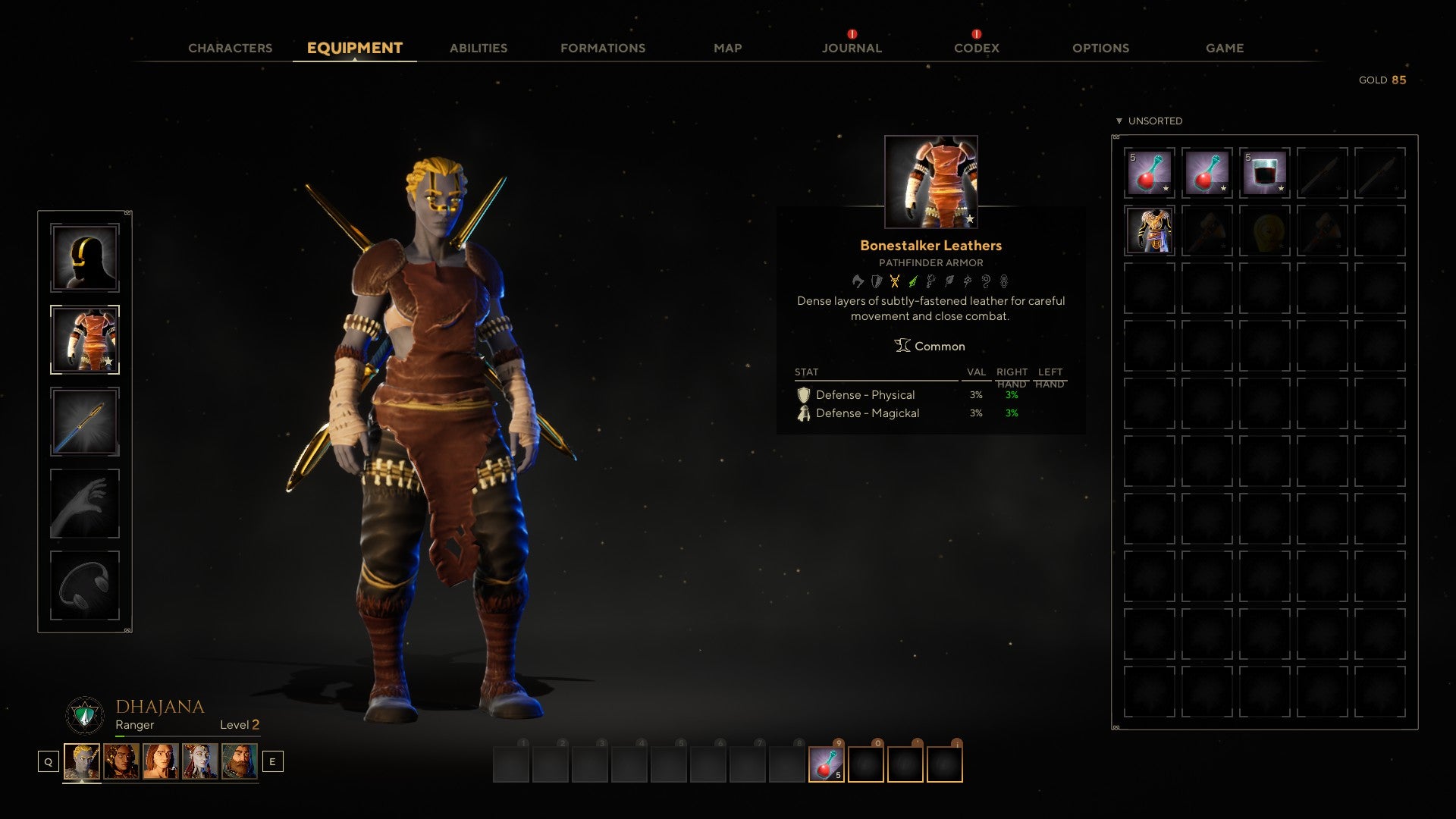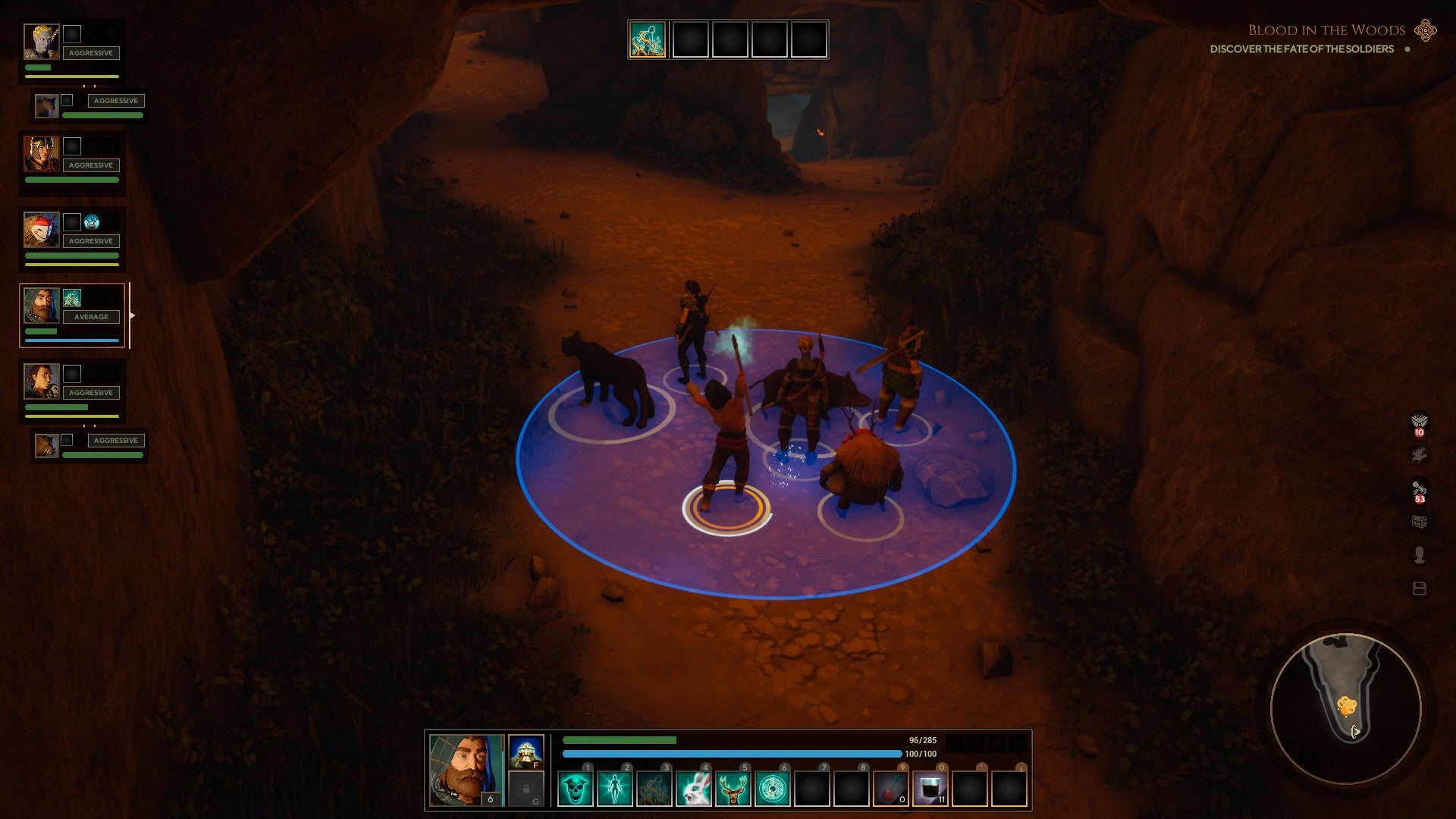For every aspect of worldbuilding that I enjoyed, there was a bug that had to be overlooked. For every character that I found charming, there was some voiceover that was jarring. For every area that was absolutely gorgeous there was a part of the script that made me extremely grateful for having editors on all my writing. Over and over, I found these flaws didn’t stop me from enjoying the core that I could see underneath. At least, until the game (as far as I can tell) bugged so badly that I literally couldn’t continue. The Waylanders is a party-based RPG, and it opens on character creation, with a hint of the fantasy world to come. Instead of dwarves and elves, the game offers Werewolves, Mourians, and Formorians, the latter two being big underground-living folks and bigger, deeper underground-living folks respectively. I settled on a Mourian, my interest piqued by their carved-bead eyes and golden body paint. From there I was thrown into a world of Celtic myth that was a lot more interesting than the standard fantasy fare. The game is absolutely stunning, for starters. I usually stick to the main path in RPGs, wary of burning myself out on meaningless sidequests, but in The Waylanders I kept wanting to do even the ones the game literally labels as “chores.” I wanted to spend time in the world, mostly just to look at all the colours in the trees and tiny bits of clutter gathered around the cottages and trading posts. Quests, like in most CRPGs, involved going to a place, fighting something (yes, often big spiders, I’m afraid), and retrieving an object. The combat system in The Waylanders is pausable real time, with options to shape each of your party members’ styles to your liking. For me, this was maximising the amount of animal companions on the team. I played as a ranger who had a mountain lion, and specced a second member of the party into another ranger, who had her own boar. Our healer also had the ability to summon a sort of spirit deer, to complete the menagerie. But if, for some unfathomable reason, you’re not optimising for pets, you can use the customisation to make a nicely balanced team of companions, digging into all of their abilities and stats and items with a pleasing level of granularity. There are a lot of overlapping systems here, from weapon upgrades to team formations and aggression styles, and a lot of it is left open for the player to figure out for themselves, so you may need a little experience with the genre to properly engage with it. (Alternatively, turn the difficulty way down to “cinematic” and watch your team satisfyingly roll over everything.) The team themselves are a fun bunch, and I wanted to get to know them better. As well as having the traditional muscle-tank, sarcastic rogue, healer attuned with nature and so on, there are some compelling twists to the archetypes. My favourite was the Formorian Delga, a young woman who has lived her whole life trapped underground and enthusiastically introduces herself as a tour guide of many years – and you’re her very first customer. When she leaves with you, she likes to see the sky and drink ale, though she’s worried about how she (and her rubbery-skinned, single-eyed head) will be perceived by surface dwellers. Also, she hits things very hard with a hammer. I love her. Unfortunately, though, most of these characters don’t get to live up to their potential. Probably because the game itself isn’t that long, the loyalty quests for your companions come around very quickly, before you really have a chance to feel any kind of connection with them. One character, who is immortal, asked me to accompany him to the village where he abandoned his mortal wife and their children out of cowardice when he realised that he would inevitably outlive them. He gave a very touching speech, but I had known him all of twenty minutes. You may notice that I haven’t used his name here – because I don’t remember it. Another character, Amergin, the druidic sage, confessed his love to me when I was a couple of hours into the game, which felt really rather abrupt. Even in game time, I think we’d known each other maybe a couple of weeks, max. More amusingly, he seemed to forget that he had done this several times, and we had to go through the whole affair again, more than once, which just left him feeling a little bit creepy. While obviously not intentional, Amergin’s amnesiac obsession was emblematic of the bugs that are littered through The Waylanders. As well as missing quest descriptions, subtitles falling out of line, and one hard crash to desktop, characters would often talk about things that had never happened, or repeat things we had already covered. These multiplied the further into the game I went, particularly after the time skip that was touted as part of the game’s big 1.0 update. Unfortunately, I can’t tell you much about it, because not long after mysteriously being flung centuries into the future, the main quest appears to have bugged entirely for me. This is annoying not just because of the review, but because I really want to finish the game. The Waylanders charmed me even where it struggled, until it struggled so hard that I literally could not continue. There were at least two big patches deployed in the last few days, and I hope that the developers manage to resolve many of these issues – for their sakes, as well as players’, and also for me. I want to know what Delga’s loyalty quest is like, whether or not it’s as abrupt as some of the others. I want to fondly overlook a < missing_text_string > because the village market is full of tiny, beautiful vegetables. I want to save the world, maybe. I’m still not really sure what’s going on there. I hope I get to find out.


